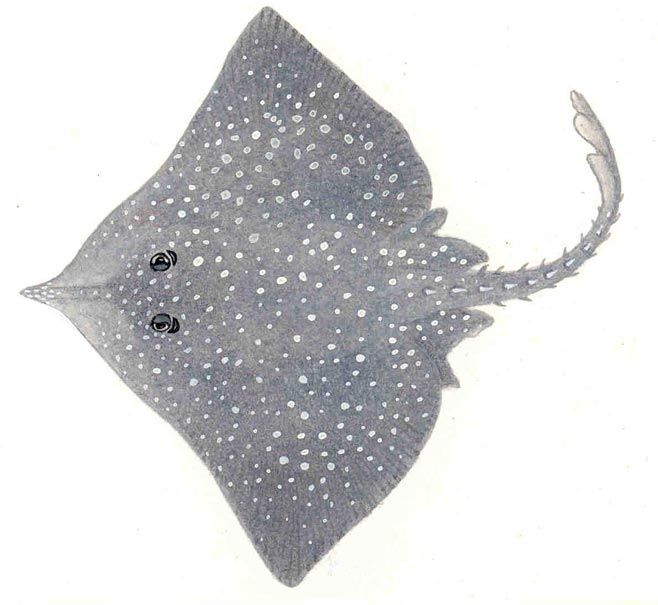|
Rostroraja alba (Spearnose skate)
(Lacepede, 1803
Life
> Eukaryotes >
Opisthokonta
> Metazoa (animals) >
Bilateria >
Deuterostomia > Chordata >
Craniata > Vertebrata (vertebrates) > Gnathostomata (jawed
vertebrates) > Chondrichthyes > Elasmobranchii > Batoidei >
Rajoidei > Rajidae
 |
|
Rostroraja alba (Spearnose skate) [Illustration
by Ann Hecht ©] |
Identification
A giant skate with a broad-based, abruptly
narrow-tipped snout covered with small sharp thorns, angular
pectoral disk, no large thorns on nape and back, three rows of large
thorns on tail. Hatchling young are plain reddish-brown above, often
with blue spots, and white below with broad dusky grey margins on
the disk; larger immatures and adults are grey above with numerous
small white spots, white below. Underside without black pores.
Size
To at least 2.3 m TL and about 1.8 m DW.
Range
Virtually the entire
area, from Namibia to central Mozambique; Eastern Atlantic and
Mediterranean Sea.
Habitat
Found mainly on sandy bottom, in
shallower water off the Cape coast than Natal and southern
Mozambique, where it ranges from 30 to 366 m. In western Cape it is
often found close inshore, in the intertidal and subtidal in shallow
bays.
Biology
Common. A formidable bottom predator that eats bony
fish, including hake, kingklip, anchovy, gobies, maasbanker,
gurnard, snoek, round herring, horsefish, sandrat, greeneye, elf,
sole, and monkfish, fish offal, other elasmobranchs including
biscuit skates, dogfish, izak and yellowspotted catsharks, crabs,
shrimp, mysids, octopi and cuttlefish. Eggs are laid in huge cases
that take up to 18 months to hatch.
Human Impact
Caught by shore
and skiboat anglers and by commercial trawlers. When hooked it gives
a powerful fight. Its heavy jaws can give a painful bite, as one of
us can attest.
Text by Leonard J.V. Compagno, David A. Ebert
and Malcolm J. Smale
|
